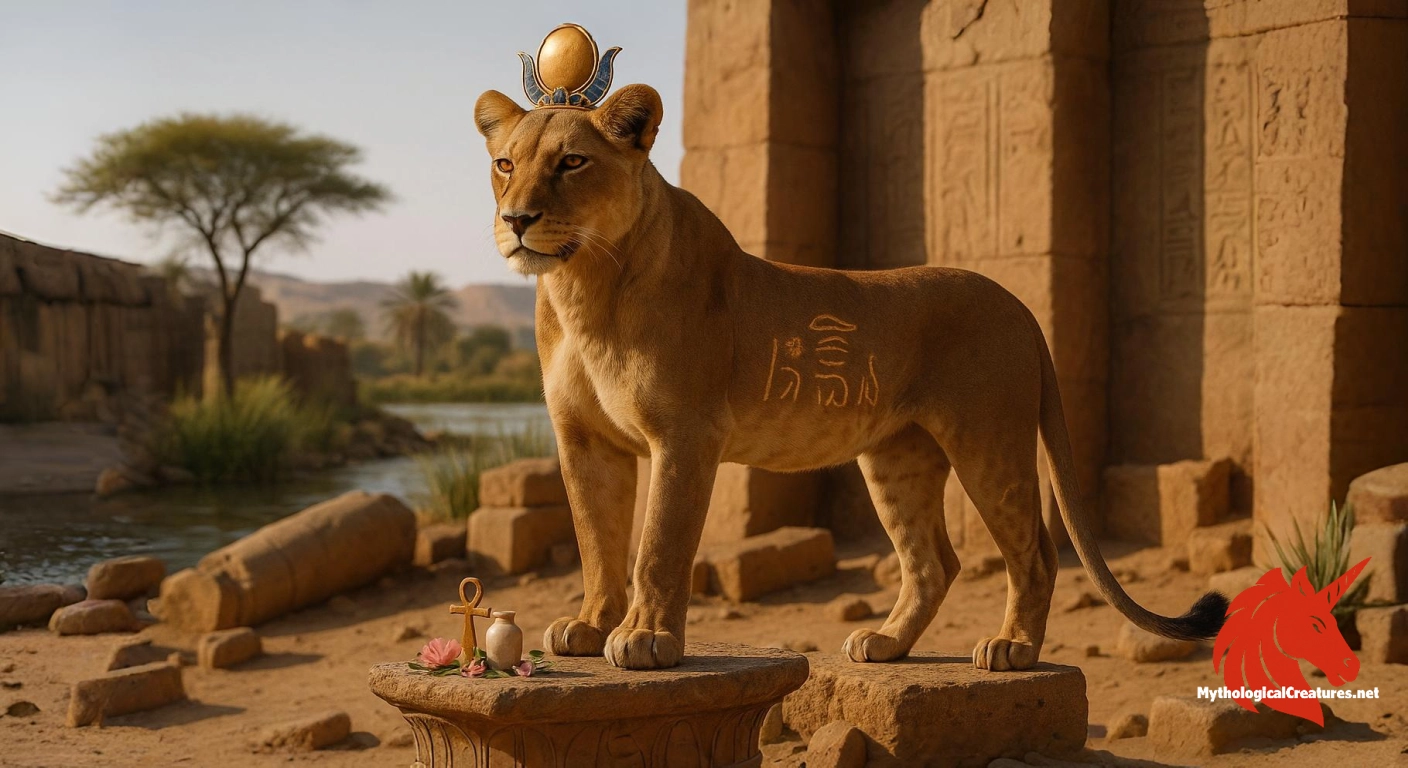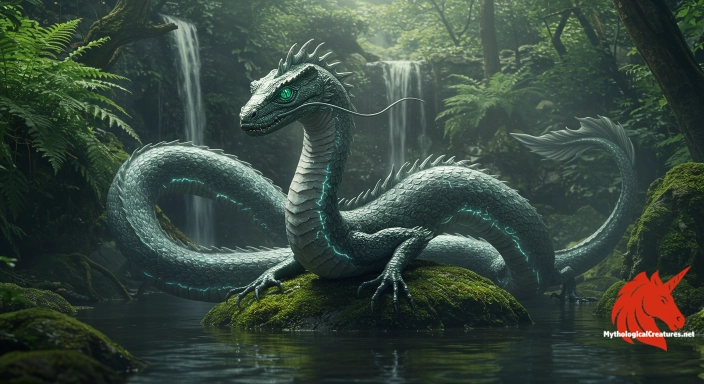Mehit: Mehit, also known as Mehyt or Mekhit, is an ancient Egyptian and Nubian lion goddess celebrated for her fierce and protective nature.

Mehit
Mehit - Represents the fierce and protective aspects of divinity in lion form
Origins & First Encounters
Mehit emerges from the tapestry of ancient Egyptian and Nubian mythologies as a formidable lion goddess whose origins are deeply rooted in the cultural interchanges of these ancient lands. Her cult appears to have been established in Nubia, where the lion was revered as a symbol of both strength and protection. Early attestations suggest that her worship may have predated more formalised Egyptian deities, marking her as a unique fusion of indigenous traditions. Over time, her iconography was adopted into Egyptian religious art, creating a striking synthesis of Nubian ferocity and Egyptian divine symbolism. Variations in her name, including Mehyt and Mekhit, reveal a flexible identity that adapted to different linguistic and cultural contexts. The rituals and symbols associated with Mehit speak to a goddess whose dual nature encapsulated both creation and destruction. Devotees saw her as a guardian in battle and a protector in the afterlife, embodying the fierce energies of the natural world. Her legacy, although not as extensively documented as some of her counterparts, continues to evoke fascination due to its enigmatic and potent blend of qualities. The enduring appeal of her myth lies in the combination of raw animal strength with a spiritual authority that transcends regional boundaries. In many ways, Mehit represents the dynamic interplay between human civilisation and the untamed forces of nature.
Source Texts & Tale Variants
The primary sources relating to Mehit are relatively scarce but offer intriguing glimpses into her role as a lion goddess. Ancient temple inscriptions and funerary texts occasionally mention her symbolically, highlighting her association with both protection and warfare. Scarce reliefs and fragmentary inscriptions from temple walls suggest that her image was revered in specific locales, particularly in Nubian vicinities. Although detailed mythological narratives about her are limited, variations in her name found in different texts—such as Mehyt and Mekhit—indicate a plurality of oral traditions that eventually influenced written records. Some late-period texts hint at a syncretism between Mehit and other more well-known lion goddesses of the region. Additionally, artefacts like statuettes and amulets bear stylistic marks that point to her influence in both ritualistic and daily life. The intermingling of Egyptian and Nubian iconographic elements in these sources reflects a dynamic cultural exchange. Even though the records are fragmentary, they allow modern scholars to piece together aspects of her narrative and significance. Each surviving reference contributes a small yet valuable part of the mosaic that portrays her dual role as both protector and warrior. Collectively, these sources illuminate the complexities of a goddess whose story continues to evolve with each new discovery.
Form & Powers
Mehit is most commonly depicted as a majestic lioness, her physical form exuding both elegance and formidable power. Her head is rendered with sharp, striking features—piercing eyes, a proud muzzle, and a set of finely detailed ears that suggest acute awareness. Artistic representations frequently merge her natural likeness with divine attributes such as a radiant sun disc or a rearing uraeus, underscoring her elevated status. The depiction of her muscular body conveys the dynamism of a predator perfectly poised to pounce, symbolising both raw strength and divine vigilance. In some artworks, hints of human grace are interwoven with her animal form, creating a composite figure that is at once fearsome and nurturing. The texture and flow of her mane are often enhanced with ornate detail, sometimes resembling a crown that signifies her regal authority. Fine renderings of her claws and sinewy limbs invite the viewer to appreciate the artistry that balances natural realism with spiritual symbolism. Colourful palettes using golds, deep reds, and earthy tones enrich her portrayal, reinforcing her connection to both the sun and the terrestrial realm. Variations in style reflect regional artistic preferences, with some depictions leaning towards a more literal animal form and others embracing metaphorical ornamentation. Such detailed portrayals ensure that every aspect of her anatomy communicates the timeless power and allure of the divine lioness.
Regional Faces
In Egypt, Mehit’s representation is deeply influenced by the conventions of lioness iconography, yet she is distinctly marked by her Nubian roots. Egyptian artistic conventions often incorporate symbolic embellishments such as the solar disc or traditional crowns that lend her an air of celestial authority. In contrast, the Nubian portrayals of Mehit reveal a raw, unbridled depiction of the lion, emphasizing naturalistic features that celebrate the untamed beauty of the animal. The different regional artistic styles highlight variations in worship practices, with Nubian iconography favouring a more authentic representation of the animal's physicality and temperament. Her dual names, Mehyt and Mekhit, derive from local dialects that further emphasise her rootedness in Nubian culture. While Egyptians integrated her image into a broader pantheon of deities, Nubians maintained a more isolated and nature-centric view of her divine power. Local rituals in Nubia often celebrated the wild aspects of her character, linking her to the rugged landscape and the primal forces of nature. This differential portrayal underscores a broader cultural conversation between the organised state religion of Egypt and the more animistic traditions of Nubia. The cross-pollination of these divergent expressions resulted in a multi-layered character whose identity expanded beyond geographical confines. Ultimately, the regional variations in her portrayal demonstrate the fluidity and adaptability of myth in response to local cultural needs.
Cultural Parallels
Examining Mehit alongside similar deities reveals a fascinating pattern of cross-cultural symbology, particularly among lion goddesses of the ancient world. Her attributes often draw comparisons with Sekhmet, another Egyptian lioness deity who embodies destruction and healing, yet Mehit’s Nubian origin imparts her with a unique edge. Alongside Sekhmet, Mehit shares thematic bonds with other Near Eastern figures who personify the duality of protection and ferocity. The common thread among these deities is the lion’s role as an emblem of royalty, power, and the protective forces of nature. In distant traditions, parallels can also be drawn with deities who, while not lion-headed, evoke the same primal energy and resolve, thereby linking disparate mythological systems under a shared symbolic language. Her image resonates with myths that celebrate the warrior spirit, a motif echoed in various cultures from Mesopotamia to the Mediterranean. Artists and theologians alike have long been intrigued by the idea of a divine force that is as capable of nurturing as it is of enacting vengeance. The comparative analysis highlights that despite regional differences, the lion as a symbol remains universally potent. This shared archetype demonstrates that while the details of her myth may vary, the intrinsic values of strength, protection, and regality are consistently revered. In this light, Mehit stands as a prime example of how mythologies evolve while retaining core universal themes.
Legacy & Modern Evolution
Over the centuries, Mehit’s portrayal has undergone significant evolution, reflecting broader changes in religious and cultural dynamics. Initially revered in tightly knit Nubian communities and gradually incorporated into the Egyptian pantheon, her image has been continuously reshaped by successive generations. The synthesis of her early, more animalistic depictions with later, highly stylised forms illustrates the dynamic nature of myth-making in ancient societies. During periods of cross-cultural interaction, particularly in the Greco-Roman era, her original attributes were reinterpreted to align with emerging aesthetic and spiritual trends. In modern times, renewed academic interest has led to a reassessment of her role, recognising the importance of Nubian influence within Egyptian mythology. Contemporary artists and cultural commentators have embraced Mehit as a potent symbol of feminine strength and transformative power, often reimagining her in various media. This modern reinterpretation emphasises both her primal ferocity and her role as a guardian, reflecting current values of empowerment and resilience. Archaeological discoveries and scholarly research continue to shed new light on her ancient worship, reigniting debates about the interplay between regional traditions and state-sponsored religion. In these ways, Mehit has transcended her historical confines to emerge as a timeless icon, bridging ancient spirituality with modern cultural narratives. Her legacy today is a testament to the enduring allure of mythological figures who embody the raw and sublime energies of existence.
Interesting Fact
Mehit's fierce lioness form serves as a powerful reminder of how ancient cultures revered animals as embodiments of divine attributes, merging the natural and the supernatural.
Quick Creature Info
Origin:
Features:
Associations:
Our Mythic Legendary Rating:

Also Sometimes Known As:
Habitat:
Supernatural Powers:
Physical Attributes:
Abilities:
Behavior:
Lore:
References
Discover Another Mythical Legend You May Not Have Heard Of?
Uncover the mysteries of ancient folklore and expand your knowledge of legendary beings from cultures around the world.
Dare to Meet the Imugi....
Mythical Disclaimer: The images and data on this site are derived from various historical and literary sources, but we have found that many myths often have multiple versions and interpretations across references, sometimes contradictory. As a result, these creature depictions are artistic interpretations—imaginative blends of folklore, legend, and a dash of AI guesswork. Because creature descriptions vary widely, our illustrations and accompanying information represent our best effort to honor mythology while bridging creative gaps. Enjoy these interpretations—just remember, we've done our best to respect the stories and validate available data, but in the realm of mythology, details often shift, imagination leads the way, and nothing is ever set in stone!
Curated by the Mythological Creatures Team (rev. May 2025)
